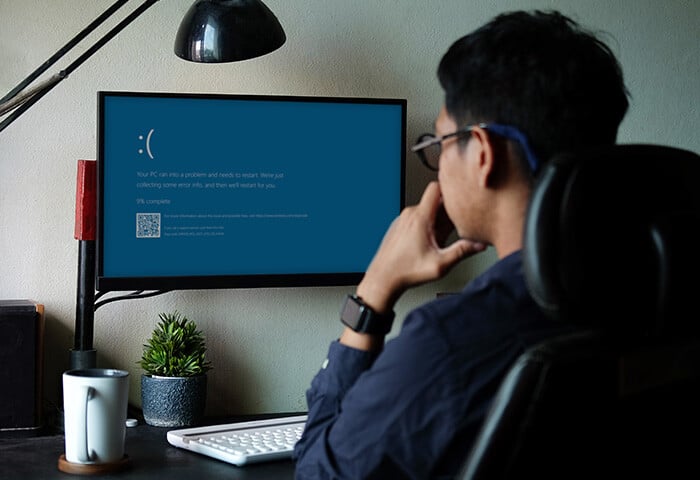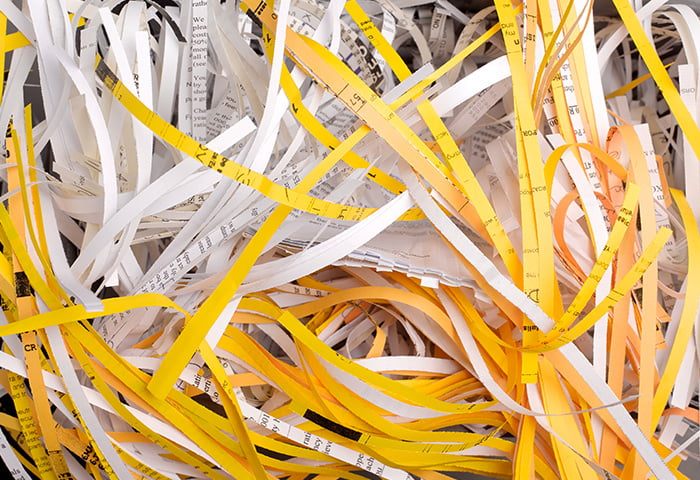Disk space refers to the total storage capacity available on a computer's hard disk or hard drive. It’s typically taken up by the operating system, applications, and files like music, documents, images, and videos.
You should regularly free up disk space to accommodate temporary files, conserve space for operating system updates, prevent disk fragmentation, and avoid failed software updates. So, let’s look at how you can give your hard drive breathing room by clearing disk space.
1. Check your free disk space
Check your available storage to find out how much disk space is being used, and by what. This will help you decide how much space you need to clear, and which methods of freeing storage space are the best options for you.
How to check disk space on Windows 10 & 11
Here’s how to check disk space on a PC running Windows 10 or 11:
-
Press the Windows key + E to open File Explorer, then click This PC. Locate the drive you want to check on the right-hand side.
-
Under the drive listing, you’ll see the free space available and the total size. For more details, right-click the drive, then select Properties.

How to check disk space on Mac
To check disk space on macOS Sonoma or Ventura:
-
Open the Apple menu, then click System Settings.
-
Click General, then Storage on the right. Your Storage information will then appear in the top right.

To check disk space on macOS Monterey or earlier versions click the Apple menu > About This Mac > Storage.
2. Move files to external storage
Transferring files to external storage — such as an external hard drive or a cloud service — can free up valuable space on your computer while ensuring your files remain accessible when needed. It's good practice to move or back up important files to cloud services or external drives anyway in case your computer gets a virus or experiences technical issues.
Fixing disk usage will help optimize your PC’s performance. There are plenty of great cloud storage options if you don’t have a favorite already — some of the most popular are OneDrive, iCloud, Google Drive, or Dropbox.
3. Empty the trash or recycle bin
Permanently deleting files from your computer’s trash or recycle bin is a quick and easy way to free up space:
-
Windows: Right-click the Recycle Bin icon on your desktop, then select Empty Recycle Bin.
-
Mac: Click the Trash icon in the dock, then select Empty.
4. Uninstall apps and programs
To free up valuable hard drive space, remove unused and unnecessary apps, such as bloatware. Unwanted applications are low-hanging fruit to target in a disk clean-up, and can significantly increase available hard disk space.
Be careful when removing system apps — always double-check that removing them won’t cause system issues. A great way to uninstall these types of apps is using a disk cleanup tool like AVG TuneUp. It will locate apps that are safe to remove so you can uninstall them with the click of a button.

Uninstall apps on a Windows 10 or 11 PC
To uninstall unwanted apps on your Windows computer:
-
Open Settings > Apps > Apps & features (Installed Apps on Windows 11).
-
Sort by Size (Large to small) and look at the space each app occupies.
-
Select an app you don’t use (on Windows 11 click the three dots next to the app) and choose Uninstall. Repeat as needed.
Uninstall apps on a Mac
To offload apps on MacOS:
-
Open Launchpad. Click and hold an app you want to uninstall until all apps start to jiggle.
-
Click the X next to the app icon, then Delete to confirm. Repeat as needed.
If the Delete button (X) doesn’t appear, it means the app can't be removed from Launchpad. You'll need to use Finder on your Mac to uninstall the app.
Uninstall apps from Finder
To uninstall an app from Finder:
-
Open Finder > click Applications in the sidebar.
-
Find the app you want to uninstall and drag it to the Trash in the Dock.
5. Delete unnecessary user accounts on your computer
You can also free up space on your disk drive by deleting unnecessary user accounts that are no longer used.
Delete other Windows users
To delete a Windows user account:
-
Open Settings > Accounts > Family & other users (Other people in Windows 10).
-
Select the user account you want to delete. Click Remove > Delete account and data.
Delete other Mac users
To remove a Mac user account:
-
Go to Apple menu > System Settings/Preferences > Users & Groups.
-
Click the i next to the user, then Delete User.
6. Compress files
Compressing files or folders into ZIP or RAR files can free up space on your hard drive and speed up backup, restoration, and file-sharing processes. Since compressed files must be decompressed before being opened, this solution is best for files you don’t regularly use.
Compress files on Windows
To compress files into a ZIP format on Windows:
-
Right-click the file or folder you want to compress, choose Compress to (Send to io Windows 10), then ZIP File (Compressed zipped folder on Windows 10).
-
A new zipped file or folder with the same name will be created in the same location.
-
Delete the original.
Compress files on Mac
To compress files into a ZIP format on Mac:
-
Open Finder, then control-click the relevant file/folder and select Compress [file name].
-
A new version with the extension .zip will be created.
-
Delete the original.
7. Use a disk cleanup tool
To help find more deeply buried files and other junk, you can use a dedicated disk cleanup tool. Both Windows and Mac offer limited in-built tools to help users manage and free up storage space. Or you can take advantage of a dedicated third-party cleanup tool like AVG TuneUp, which goes beyond regular cleaning.
Clean up with AVG TuneUp
Use a trusted third-party cleanup program like AVG TuneUp to quickly find bloatware, temporary files, and more — including junk that in-built tools often miss. Enjoy faster performance and startup speeds, plus automatic program updates to help avoid security risks.
Windows Disk Cleanup
To free up disk space on Windows 10 or 11, you can also use the built-in Disk Cleanup tool, which removes unnecessary files, including obsolete Windows files and items in the Recycle Bin.
-
Search Disk Cleanup using the taskbar and open the program.
-
Tick the boxes next to the file types you wish to delete, then click OK.

Generally, all items listed by Disk Cleanup are safe to delete, except for Windows ESD Installation Files (you’ll need these if you ever want to reset your PC).
Turn on Windows Storage Sense
When Storage Sense is on, it clears out temporary files automatically — helping to keep your disk storage under control. You can also adjust the settings so it deletes items from the Recycle Bin and Downloads.
Storage Sense is built into Windows 10 and 11 but is disabled by default. Here’s how to turn on Windows Storage Sense:
-
Click Start > Settings > System > Storage.
-
Toggle on Storage Sense.

Optimize your Mac storage
The storage settings on Mac include built-in features to optimize your storage and help clean up a Mac.
-
Open the Apple menu > System Settings > General > Storage. (On macOS Monterey or earlier, go to the Apple menu > About this Mac > Storage tab.
-
You can choose to automatically send files to iCloud, optimize storage (e.g., remove movies and TV shows you’ve already watched), and have the trash emptied every 30 days.

8. Delete files you're no longer using
You can manually locate and delete files that you no longer use like photos, music, duplicate files, and downloads to reclaim space.
However, always be cautious when deleting files on your PC or Mac that you don’t recognize — they may be essential for system operation. Back up any files you might need in the future, or if you’re unsure of their importance.
Delete large files
To reclaim the most space, find and delete large files and downloads such as videos and photos.
On Windows:
-
Open File Explorer, then go to Downloads or Documents.
-
In list view, sort by size, then right-click the files you want to remove and click Delete.
On a Mac:
-
Open Finder, then go to Downloads or Documents.
-
In list view, sort by size, then drag any files you want to remove to the Trash in the Dock.
Delete temporary files
You can create more disk space by deleting cache and other temporary files on your PC. These accumulate over time and while they serve a purpose at the start, they become junk files and just take up valuable disk space. You should also clear the cache on Mac regularly.
Delete duplicate files
You may not realize how many duplicate files you have because it’s time-consuming to look through all your folders to find them. But the likelihood is your device is littered with two or more of the same files. Use a cleanup program like AVG TuneUp to quickly find duplicates. It will also safely find and remove temporary files that you no longer need.
9. Delete old device backups
You can make more space on your disk drive by deleting backups you no longer need. These may be backups of your computer or another device like a mobile phone.
Delete backups on Windows
To delete a backup stored on your PC:
-
Go to Start > Control Panel > System and Security > Backup and Restore.
-
In the Backup and Restore window, click on Manage space and select the backup location from the list.
-
Click View backups and select the backup set you want to delete. Click Delete and confirm when prompted.
Delete backups on Mac
Macs delete Time Machine backups as space is needed. But if you have backups of your iPhone or iPad on your Mac, you’ll need to follow these steps to manually delete them:
-
Open Finder, connect your device with a USB cable, and choose your device if it’s not automatically selected.
-
In the General tab, click Manage Backups, right-click the backup you no longer want, and click Delete.
10. Disable hibernation mode (Windows)
Hibernation mode makes it easier for you to take a break from your computer and pick up where you left off. It does this by saving memory data in a storage file called hiberfil.sys on your C: drive. This file can be large, so disabling hibernation mode deletes the file and frees up disk space.
Here’s how to disable hibernation mode on Windows:
-
Search Command Prompt in the Start menu. Right-click the Command Prompt icon and choose Run as administrator.
-
In the Command Prompt window, type powercfg /hibernate off and press Enter to disable hibernation.
Easily maximize free disk space with AVG TuneUp
Manually freeing up, cleaning, and optimizing your computer’s disk drive can be a tedious, repetitive task, but not with AVG TuneUp.
Our lightweight and nimble cleanup and maintenance tool automatically clears out junk files, updates software, finds unnecessary programs, and performs regular maintenance tasks. Get AVG TuneUp today to keep your devices organized and running smoothly.





















